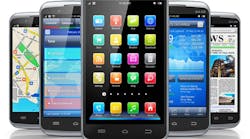I was reading some releases and other material put out by AT&T recently, and it dawned on me that cellular systems are going to play more of a major role in the IoT movement than I realized. I should have expected that, though, given that AT&T and the other major carriers have been doing IoT in the form of M2M for a decade or more.
Most M2M applications used the 2G and 3G networks for things like remote equipment monitoring and fleet tracking. However, with recent announcements from AT&T and Verizon about shutting down their 2G networks in the near future, I thought maybe M2M/IoT might not be a growth area. Boy, was I wrong. Here is what I’m seeing:
First, market data firm Machina Research expects mobile networks to carry 50% of IoT data traffic by 2025. The thing making that possible is the availability of low-cost LTE chips and modules that are ideal for many IoT applications. I am speaking of the low-power, low-speed versions of LTE specified by the 3GPPs Releases 12 and 13.
Specifically, these are designated as LTE-M (or LTE Cat-M1) and NB-IoT. LTE Cat-M1 uses the minimum LTE bandwidth of 1.4 MHz with the usual OFDMA downlink and SC-FDMA uplink. Maximum data rate is 1 Mb/s. NB-IoT uses a bandwidth of just one LTE resource block (12 OFDM 15 kHz subcarriers) of 180 kHz. It, too, uses OFDMA and SC-FDMA with a peak data rate of 250 kb/s. Both fit many IoT applications.
What makes them appealing is their low power consumption, a feature that is almost mandatory for some IoT uses. Some modules tout up to 10 years battery life for some operations. Then there is the great range and coverage up to several kilometers. And that coverage can penetrate buildings like most LTE cellular, making many indoor products possible.
Cellular LTE is going to be competing with several others in the low power wide area network (LPWAN) arena, courtesy of technologies like LoRa, Ingenu, Sigfox, and Weightless. All offer much longer range than the usual Wi-Fi or Bluetooth. These longer range wireless standards use unlicensed spectrum, which makes interference a potential problem. This is less of a problem with cellular and its licensed spectrum, making cellular IoT more reliable—an important factor to consider in a critical application.
Another serious consideration is security. Cellular networks offer carrier-grade security that is no doubt a step ahead of typical IoT security measures. And finally, low cost of modules is making cellular IoT more attractive. With module prices in the $5 to $10 range and headed lower, cellular IoT is now worth considering for some applications.
Oh yes: Cellular 5G IoT will also be available in the near future from AT&T and others. If you have applications that require many Mb/s up to 1 Gb/s, 5G is the answer. But you will need to wait until about 2018 or so for that to happen.
Another place where cellular IoT excels is in mobile applications. LTE was designed for portable and mobile use. For that reason, LTE cellular is a major consideration for use in the wireless connections that are a part of the Advanced Driver Assistance Systems (ADAS) being developed. This system will implement vehicle-to-vehicle (V2V) communications and vehicle-to-infrastructure (V2I) connections to roadside terminals. The roadside terminals also talk to the system network.
Up to now, the Department of Transportation’s (DOT) National Highway Traffic Safety Administration (NHTSA) has proposed that the Dedicated Short Range Communications (DSRC) technology be adopted. DSRC uses the IEEE 802.11p standard that is a variant of Wi-Fi. It uses 10-MHz bands in the 5.9 GHz unlicensed spectrum to achieve a data rate of 10 Mb/s. DSRC V2V radios transmit location, direction, and speed of the vehicle to other vehicles within a 300-meter range. The idea is to provide drivers with better information to prevent accidents. The DOT wants V2V in vehicles within the next few years.
In December, the NHTSA issued a notice of proposed rulemaking (NPRM) mandating DSRC in all light vehicles. Up until recently DSRC was nearly a sure thing until the FCC decided to consider the potential expansion of the 5 GHz Wi-Fi spectrum into the 75 MHz chunk of DSRC’s 5.9 GHz band. Now DSRC supporters are worried that interference from Wi-Fi could make DSRC V2V less effective and reliable. The FCC has not made a decision yet, leaving the issue open.
One solution from Qualcomm, Intel, AT&T, and others is cellular V2V. The idea is to leapfrog DSRC and go directly to cellular. LTE would be the V2V and V2I links. It will be interesting to see how this evolves. In the meantime, AT&T is joining the American Center for Mobility in the testing of V2x solutions for connected and automated vehicles (CAV). At a 355+ acre test facility in Michigan, the test partners will see how V2x works under real world conditions. AT&T will certainly be trialing LTE and its network for CAV applications. Machina Research expects connected car applications to be 45% of cellular IoT by 2025.
Anyway, look for cellular to be a bigger part of IoT than many of us thought.


